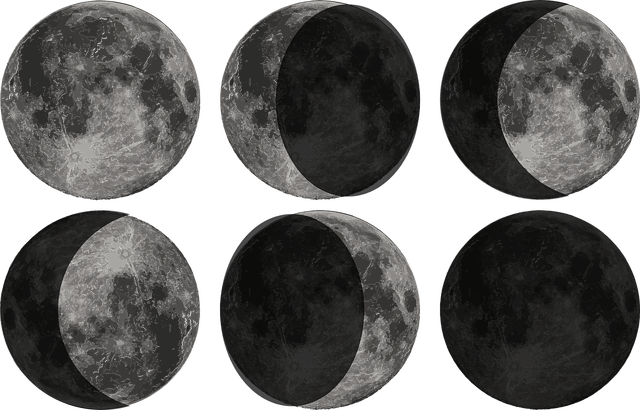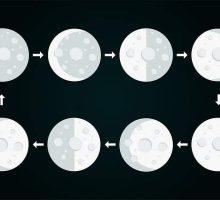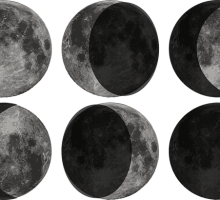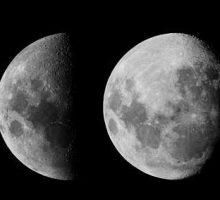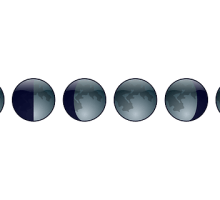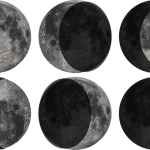- Understanding the Phases of the Moon: A Beginner’s Guide
- How Lunar Phases Affect Our Emotions and Behavior
- The Spiritual Significance of Lunar Phases in Different Cultures
- How to Use Lunar Phases for Manifestation and Setting Intentions
- The Scientific Explanation of Lunar Phases and Their Effect on Tides
- The Relationship Between Lunar Phases and Agriculture
- The Connection Between Lunar Phases and Women’s Cycles
- The Role of Lunar Phases in Astrology and Horoscopes
- The History of Lunar Phases and Their Importance in Navigation
- The Impact of Lunar Phases on Wildlife and Animal Behavior.
Understanding the Phases of the Moon
The moon has fascinated humanity since the beginning of time. It has been the subject of countless myths, legends, and scientific studies. However, for many people, the phases of the moon can be confusing. In this beginner’s guide, we’ll take a closer look at the phases of the moon, what causes them, and how to observe them.
What are the Phases of the Moon?
The moon goes through different phases as it orbits around the Earth. These phases are determined by the angle between the sun, Earth, and the moon. As the moon orbits around the Earth, different parts of it are illuminated by the sun, which creates the different phases.
There are eight main phases of the moon, which are:
- New Moon – This is when the moon is completely dark and cannot be seen from Earth.
- Waxing Crescent – This is the phase when the moon is just starting to become visible. It appears as a small crescent shape.
- First Quarter – This is when the moon appears as a half-circle shape, and is said to be in its “first quarter” of the lunar cycle.
- Waxing Gibbous – This is when the moon is more than half-lit, but not yet full.
- Full Moon – This is when the entire face of the moon is illuminated by the sun and appears as a bright, full circle.
- Waning Gibbous – This is the phase when the moon is starting to decrease in illumination and appears as a slightly less than full circle.
- Third Quarter – This is when the moon appears as a half-circle shape again, but this time on the opposite side of the first quarter.
- Waning Crescent – This is the final phase of the lunar cycle, when the moon is only a small crescent shape again, just before it becomes a new moon.
What Causes the Phases of the Moon?
The phases of the moon are caused by the relative positions of the sun, Earth, and moon. The moon orbits around the Earth, and as it does so, different parts of it are illuminated by the sun. This is because the sun is always shining on one side of the moon, while the other side is in shadow.
As the moon moves around the Earth, the angle between the sun, Earth, and the moon changes, causing different parts of the moon to be illuminated. When the moon is between the sun and the Earth, the side facing the Earth is in shadow, and this is known as a new moon. When the moon is on the opposite side of the Earth from the sun, the side facing the Earth is fully illuminated, and this is known as a full moon.
How to Observe the Phases of the Moon
Observing the phases of the moon can be a fascinating and rewarding experience. All you need is a clear view of the night sky and a little bit of patience. The best time to observe the moon is during the night when the sky is dark.
You can observe the moon with the naked eye, or you can use binoculars or a telescope for a closer look. You can also use a lunar calendar to keep track of the phases of the moon and plan your observations accordingly.
Lunar Phases and Our Emotions
Have you ever noticed a shift in your emotions or behavior during a full moon? Many people believe that lunar phases can affect our emotions and behavior, and there is some scientific evidence to support this theory. In this blog post, we’ll take a closer look at the connection between lunar phases and our emotions, and explore some of the ways in which lunar cycles may impact our lives.
How Lunar Phases Affect Our Emotions
The moon is known to affect the tides of the ocean, and many people believe that it can also affect our emotions. According to some researchers, the lunar cycle may impact our mood by influencing the levels of certain hormones in our body, such as melatonin and serotonin.
Melatonin is a hormone that regulates our sleep-wake cycle, and it is known to be influenced by light. During a full moon, the moon’s brightness may disrupt our melatonin production, leading to a restless night’s sleep and an overall decrease in our mood. On the other hand, serotonin is a hormone that affects our mood, appetite, and sleep. During a full moon, serotonin levels may increase, leading to feelings of happiness and well-being.
Additionally, some studies have suggested that lunar cycles may impact our behavior and decision-making. One study found that people were more likely to engage in risky behavior during a full moon, while another study suggested that people were more likely to make impulsive purchases during a full moon.
The Spiritual Significance of Lunar Phases
In addition to the scientific explanations for the effects of lunar phases on our emotions and behavior, many people also believe in the spiritual significance of lunar cycles. In many cultures, the full moon is seen as a time of heightened spiritual energy and a time to set intentions or release negative energy. The new moon, on the other hand, is seen as a time of new beginnings and a time to set goals and intentions for the coming lunar cycle.
How to Harness the Power of Lunar Phases
If you’re interested in harnessing the power of lunar phases, there are several ways to do so. Some people choose to meditate or perform a ritual during the full or new moon, while others prefer to simply observe the moon’s cycles and reflect on how they are feeling.
Keeping a lunar journal can be a helpful way to track your emotions and behavior during different phases of the moon. You can also use a lunar calendar to plan your activities and set intentions based on the phase of the moon.
The Cultural Significance of Lunar Phases
The moon has been a source of wonder and fascination for people throughout history. Its cycles have been observed and interpreted in various ways by different cultures around the world, and the spiritual significance of lunar phases remains an important part of many cultural traditions. In this blog post, we’ll take a closer look at how lunar phases are viewed in different cultures and explore the spiritual beliefs associated with each phase.
New Moon
In many cultures, the new moon is viewed as a time of new beginnings and fresh starts. It is a time to set intentions, make plans, and focus on personal growth. In Hinduism, the new moon is celebrated as Amavasya, a day of prayer and meditation. In Chinese culture, the new moon is celebrated as the start of a new month on the lunar calendar and is associated with new opportunities and good fortune.
Waxing Moon
As the moon moves from new to full, it is said to be in its waxing phase. This phase is associated with growth, abundance, and prosperity. In Wiccan traditions, the waxing moon is viewed as a time to focus on manifestation and the attainment of goals. In Native American culture, the waxing moon is associated with the growth and renewal of life in nature.
Full Moon
The full moon is perhaps the most well-known phase of the lunar cycle, and it is associated with a range of spiritual beliefs in different cultures. In many traditions, the full moon is seen as a time of heightened spiritual energy and a time for rituals and celebrations. In Hinduism, the full moon is celebrated as Purnima, a day of prayer and offerings to the gods. In Buddhism, the full moon is celebrated as a time of enlightenment and is associated with the teachings of the Buddha.
Waning Moon
As the moon moves from full to new, it is said to be in its waning phase. This phase is associated with release, letting go, and surrender. In Wiccan traditions, the waning moon is viewed as a time to release negative energy and habits. In Native American culture, the waning moon is associated with the end of a cycle and the preparation for a new one.
Using Lunar Phases to Manifest Your Intentions
The moon has long been revered as a powerful force in our lives. Its gravitational pull affects the tides, our emotions, and even our bodies. But did you know that you can use lunar phases to manifest your intentions and bring positive change into your life? In this blog post, we’ll explore how to use lunar phases for manifestation and setting intentions.
New Moon
The new moon is the perfect time to set your intentions for the lunar cycle ahead. As the moon begins its journey towards fullness, it’s a time for planting seeds and making new beginnings. Take some time to reflect on what you want to bring into your life over the next few weeks. Write down your intentions, and be as specific as possible. Visualize yourself already having achieved your goals, and feel the emotions associated with your success. This will help to align your energy with your intentions and set the stage for manifestation.
Waxing Moon
As the moon moves towards fullness, its energy is focused on growth and expansion. This is the time to take action towards your goals and manifest your intentions. Use the energy of the waxing moon to make progress towards your goals, and take steps towards bringing your intentions to fruition. Keep your focus on the positive outcome, and trust that the universe will bring you what you need to achieve your goals.
Full Moon
The full moon is a time of heightened energy and manifestation. This is when the intentions you set at the new moon may come to fruition, and you may see the results of your efforts. Take some time to reflect on your progress, and express gratitude for all that you have achieved. Use the full moon energy to release any negative energy or limiting beliefs that may be holding you back, and allow yourself to receive the abundance and blessings that the universe has in store for you.
Waning Moon
As the moon begins to wane, its energy is focused on release and letting go. This is the time to release any negative energy or limiting beliefs that may be standing in the way of your manifestation. Use this time to reflect on any areas where you may be blocking your own success, and make a conscious effort to let go of any beliefs or habits that are no longer serving you. Trust that by releasing these blocks, you are creating space for new opportunities and blessings to come into your life.
Understanding the Science Behind Lunar Phases and Their Impact on Tides
The moon has always fascinated humans, and its impact on the tides is one of its most significant influences on the planet. The gravitational pull of the moon on the Earth’s oceans creates tides, which are essential for life on Earth. In this blog post, we’ll explore the science behind lunar phases and their effect on tides.
The Basics of Lunar Phases
The moon orbits around the Earth, and as it does so, it appears to change shape. This change in shape is what we refer to as lunar phases. The cycle of lunar phases starts with a new moon, when the moon is between the Earth and the Sun, and its dark side faces us. As the moon moves around the Earth, we see different amounts of the illuminated side, leading to the different phases of the moon. The full moon occurs when the entire illuminated side of the moon faces the Earth.
How Lunar Phases Affect Tides
The gravitational pull of the moon on the Earth’s oceans creates tides. The moon’s gravity creates a tidal force that pulls the water towards it, causing a high tide on the side of the Earth facing the moon and a second high tide on the side of the Earth opposite the moon. These high tides are known as spring tides and occur during the full and new moons.
During the first and third quarter lunar phases, the moon is at right angles to the Sun and the Earth, creating a weaker tidal force. This weaker tidal force results in lower tides, known as neap tides.
The Science Behind Tides
The science behind tides is based on Newton’s law of universal gravitation, which states that every object in the universe exerts a gravitational force on every other object. The strength of the gravitational force depends on the masses of the objects and the distance between them. The moon’s gravity is weaker than the Earth’s gravity, but because it is so close, it has a significant impact on the tides.
The position of the Sun also affects tides, but to a lesser extent than the moon. When the Sun and moon are aligned, their combined gravitational force leads to stronger tides. When they are at right angles to each other, their gravitational forces partially cancel each other out, resulting in weaker tides.
Understanding the Relationship Between Lunar Phases and Agriculture
The moon has been known to have a significant influence on various natural phenomena on Earth, and agriculture is one of them. For centuries, farmers have relied on lunar phases to determine the best time to plant, harvest, and perform other agricultural activities. In this blog post, we’ll explore the relationship between lunar phases and agriculture.
Understanding Lunar Phases
The moon goes through various phases in its orbit around the Earth, and these phases can be divided into four main categories: new moon, first quarter, full moon, and third quarter. The lunar phases occur as a result of the interaction between the moon, Earth, and Sun. During a new moon, the moon is between the Earth and the Sun, and its illuminated side faces away from us. During a full moon, the entire illuminated side of the moon faces the Earth.
The Impact of Lunar Phases on Agriculture
Many farmers believe that the lunar phases can influence the growth and yield of their crops. The lunar phases are thought to affect plant growth by influencing the movement of water and sap within the plants. During a new moon and a full moon, the gravitational pull of the moon on the Earth is stronger, leading to higher tides. This increased gravitational force is thought to cause more moisture to be pulled up into the soil and into the plants, resulting in better plant growth.
The lunar phases are also believed to influence the timing of agricultural activities such as planting and harvesting. For example, farmers may choose to plant crops during a waxing moon (the period between a new moon and a full moon) as this is believed to be the optimal time for plant growth. On the other hand, a waning moon (the period between a full moon and a new moon) is believed to be the best time for pruning and weeding.
Scientific Evidence for the Relationship Between Lunar Phases and Agriculture
While the relationship between lunar phases and agriculture has been observed for centuries, there is still ongoing scientific research into this phenomenon. Some studies have shown that certain agricultural activities, such as planting, can be affected by the lunar phases. For example, a study published in the Journal of Plant Physiology found that soybean seedlings grew faster and had higher chlorophyll content when they were exposed to a full moon compared to a new moon.
However, other studies have shown no significant correlation between lunar phases and crop growth. For example, a study published in the Journal of Crop Science found no evidence that lunar phases affected the yield of corn crops.
The Connection Between Lunar Phases and Women’s Cycles
For centuries, women have observed a connection between their menstrual cycles and the phases of the moon. This has led to the belief that lunar phases can affect women’s reproductive health and fertility. In this blog post, we’ll explore the connection between lunar phases and women’s cycles.
Understanding Menstrual Cycles
The menstrual cycle is the regular process of changes that occur in a woman’s body to prepare for pregnancy. It is regulated by hormones and typically lasts 28 days, although it can vary from woman to woman. The menstrual cycle is divided into three phases: the follicular phase, the ovulatory phase, and the luteal phase.
The Impact of Lunar Phases on Women’s Cycles
Many women believe that the phases of the moon can affect their menstrual cycles. Some women claim that their menstrual cycles are synced with the lunar cycle, while others believe that the moon’s gravitational pull can affect the timing and intensity of their periods.
The full moon is often associated with ovulation and fertility, and some women try to conceive during this phase. On the other hand, the new moon is often associated with menstruation and a time for rest and introspection.
Scientific Evidence for the Connection Between Lunar Phases and Women’s Cycles
While there is no scientific evidence to support the belief that lunar phases can directly affect women’s cycles, some studies have found a correlation between lunar phases and menstrual cycles. For example, a study published in the American Journal of Obstetrics and Gynecology found that the average length of the menstrual cycle was slightly longer during the full moon compared to other lunar phases.
However, other studies have found no significant correlation between lunar phases and menstrual cycles. For example, a study published in the Journal of Obstetrics and Gynaecology Canada found no evidence that the lunar cycle affected the timing of ovulation or the length of the menstrual cycle.
The Role of Lunar Phases in Astrology and Horoscopes
Astrology is a practice that has been around for thousands of years, and it is based on the belief that there is a connection between celestial phenomena and human affairs. One of the key components of astrology is the use of horoscopes, which are based on the position of the sun, moon, and planets at the time of a person’s birth. In this blog post, we will explore the role of lunar phases in astrology and horoscopes.
The Moon in Astrology
In astrology, the moon is considered to be one of the most important celestial bodies. It is associated with emotions, intuition, and the unconscious mind. The position of the moon at the time of a person’s birth is said to have a significant influence on their personality, behavior, and life path.
Lunar Phases in Astrology
The phases of the moon also play an important role in astrology. The lunar cycle is divided into eight phases, each of which has its own unique energy and symbolism. These phases are:
- New Moon – A time of new beginnings, fresh starts, and setting intentions.
- Waxing Crescent – A time for taking action towards your goals and manifesting your desires.
- First Quarter – A time for taking action and making progress towards your goals.
- Waxing Gibbous – A time for refinement, tweaking your plans, and making adjustments.
- Full Moon – A time of heightened emotions, manifestation, and release.
- Waning Gibbous – A time for introspection, reflection, and gratitude.
- Last Quarter – A time for releasing what no longer serves you and preparing for new beginnings.
- Waning Crescent – A time for rest, surrender, and reflection.
Each of these phases is associated with different astrological signs, elements, and energies. For example, the new moon is often associated with the sign of Aries and the element of fire, which represents passion, creativity, and action.
Horoscopes and Lunar Phases
Horoscopes are a popular tool used in astrology to provide insight into a person’s personality traits, strengths, weaknesses, and life path. Lunar phases play a significant role in horoscopes, as they are used to determine a person’s moon sign.
A person’s moon sign is determined by the position of the moon at the time of their birth. It is said to represent their emotional nature, instincts, and subconscious mind. Each moon sign is associated with different personality traits and characteristics, and can provide valuable insights into a person’s behavior and tendencies.
The History of Lunar Phases and Their Importance in Navigation
For thousands of years, humans have been navigating the seas using the stars and the moon. In particular, the phases of the moon have played a crucial role in navigation, allowing sailors to determine their position and calculate their course. In this blog post, we will explore the history of lunar phases and their importance in navigation.
Early Navigation
Navigation has been a crucial skill for humans since ancient times. Early navigators used landmarks such as mountains, coastlines, and rivers to help them find their way. However, these methods were not always reliable, especially in open waters, where there were no visible landmarks.
The Phases of the Moon
The phases of the moon provided a reliable way for sailors to navigate the seas. The moon goes through a cycle of phases every month, from the new moon to the full moon and back again. These phases were used to determine a ship’s latitude and longitude, as well as the time of day and the direction of the wind.
One of the key methods used by sailors was to measure the angle between the moon and the horizon. By measuring this angle at a specific time, sailors could calculate their latitude. They could also use the position of the moon and the stars to calculate their longitude.
The Importance of Lunar Phases
The phases of the moon were so important for navigation that they were included in the first almanacs, which were published in the 16th century. These almanacs provided sailors with detailed information about the position of the moon, as well as the positions of the stars and other celestial bodies.
The accuracy of lunar navigation was greatly improved in the 18th century, with the invention of the marine chronometer. This device allowed sailors to accurately determine their longitude, even when they were far from land.
Today, navigation has been largely taken over by GPS and other electronic devices. However, the phases of the moon still play a role in navigation, especially in emergency situations when electronic devices fail.
The Impact of Lunar Phases on Wildlife and Animal Behavior
The lunar cycle, with its changing phases of the moon, has been known to impact the behavior and activities of many animals. From hunting to migration, animals have adapted their behaviors to the cycles of the moon over time. In this blog post, we will explore the impact of lunar phases on wildlife and animal behavior.
Hunting and Feeding
Many animals, especially nocturnal predators, use the moon’s phases to hunt and feed. During a full moon, for example, animals such as owls and cats can see better, making it easier for them to hunt. Some animals also use the moon to navigate when hunting or foraging.
However, during a new moon, when the sky is dark, many animals may have a harder time finding food. This can lead to changes in their behavior, such as increased foraging during daylight hours.
Migration
Many animals, including birds and sea turtles, use the moon’s phases to navigate during migration. The moon’s gravitational pull can also impact the tides, creating conditions that are more favorable for migration.
For example, sea turtles use the moon to navigate during their annual migrations. They can sense the magnetic field of the earth and the location of the moon, which helps them navigate to their nesting grounds.
Reproduction and Mating
Some animals, such as certain species of fish, use the phases of the moon to time their spawning and mating. For example, salmon will swim upstream to spawn during a specific phase of the moon. Other animals, such as some species of frogs and toads, may use the moon’s phases to coordinate their mating calls.

